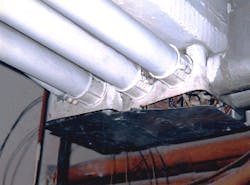Bursting at the Seams
I ran across these EMT raceways and conduit bodies in a hotel. I didn’t even have to remove the covers to see there was cause for concern about the number of circuit conductors in these boxes. Plus, the cover plates were not properly secured to the boxes.
Section 314.16 outlines the requirements for the allowable number of conductors in outlet, device, junction boxes, and conduit bodies. More specifically, it states, “Boxes and conduit bodies shall be of sufficient size to provide free space for all enclosed conductors. In no case shall the volume of the box, as calculated in 314.16(A), be less than the fill calculation as calculated in 314.16(B). The minimum volume for conduit bodies shall be as calculated in 314.16(C).”
It appears to me that these boxes are sized at 411⁄16 in. × 21⁄8 in. square. If the conductors in the box are 12 AWG, then only 18 are permitted to be installed in this sized box.
Air-Cooled Cabinet
One, two, three, four … seven open knockouts at the bottom of this cabinet! Well, I guess there’s no need for us to worry about heat buildup in this baby. The open knockouts are a violation of 110.12(A), which states, “Unused openings, other than those intended for the operation of equipment, those intended for mounting purposes, or those permitted as part of the design for listed equipment, shall be closed to afford protection substantially equivalent to the wall of the equipment. Where metallic plugs or plates are used with nonmetallic enclosures, they shall be recessed at least 6 mm (¼ in.) from the outer surface of the enclosure.”
These flexible cable assemblies were being used as permanent branch circuits in a hotel building. This is clearly a violation of the requirements in Art. 400. More specifically, as noted in 400.8, “Unless specifically permitted in 400.7, flexible cords and cables shall not be used for the following: (1) As a substitute for the fixed wiring of a structure.”
In addition, the other individual conductors should have been installed in raceways. The missing fittings in the knockouts are also in violation of 300.15 and 110.12. It’s worth referencing the informational note in 110.12, which says, “Accepted industry practices are described in ANSI/NECA 1-2006, Standard Practices for Good Workmanship in Electrical Contracting, and other ANSI-approved installation standards.”
About the Author
Joe Tedesco
Tedesco served the industry in many roles during his career. He was a director, senior electrical code instructor for National Technology Transfer, Inc. and American Trainco, Inc.. He was also a codes, standards and seminar specialist for the International Association of Electrical Inspectors and an electrical field service specialist for the National Fire Protection Association in Quincy, Mass. He ran his own business as an NEC consultant and is a Massachusetts licensed master electrician and journeyman electrician and certified electrical inspector (one and two family 2A; General 2B, and Plan Review, 2C). Tedesco also wrote articles for CEE News and EC&M (Code Violations Illustrated and What's Wrong Here?) for more than 15 years and helped launched the Moving Violations video series.
